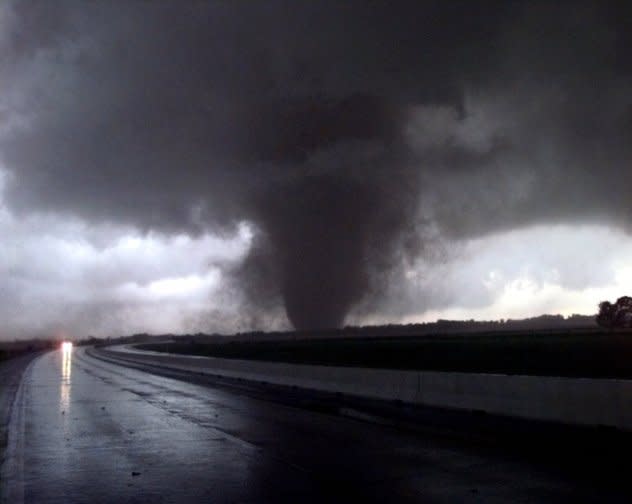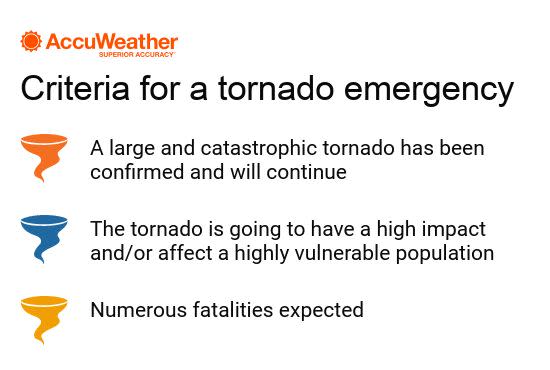What is a tornado emergency?
Tornadoes can be one of Mother Nature's most destructive forces, but advanced warnings can help save lives when a tornado is approaching.
As a strengthening thunderstorm begins to rotate, the National Weather Service (NWS) can issue a tornado warning. This means that a tornado is imminent and that people in the path of the storm need to take cover immediately.
However, when a large, destructive tornado is already on the ground for an extended period of time and is approaching a populated area, the NWS can issue a tornado emergency.
A tornado emergency means that significant, widespread damage with a high likelihood of numerous fatalities is expected to continue with a strong and violent tornado, according to the NWS. It's a call to action that people need to react to immediately. When one is issued, a confirmed tornado is causing life-threatening conditions and people need to seek shelter right away.
 |
University of Oklahoma storm chasers and observers are anticipating the annual tornado season as it approaches the central part of the country. Adding to the anticipation is the fact they observed the 78-tornadoes, including this May 3, 1999 funnel that became the F-5 storm that damaged thousands of buildings in central Okahoma, during a two day period last year. (AP Photo/J. Pat Carter) |
Tornado emergencies are rare and are only issued during significant severe weather events.
"This tornado warning is reserved for situations when a reliable source confirms a tornado, or there is clear radar evidence of the existence of a damaging tornado, such as the observation of debris," the NWS explained on its site.
Sometimes a whole year can pass without a single tornado emergency being issued anywhere in the United States.
However, if there is a tornado outbreak, a tornado emergency may be issued multiple times in just a few hours.
 |
The first tornado emergency was issued on May 3, 1999, during a historic tornado outbreak in Oklahoma.
Late that afternoon, a large and extremely dangerous tornado had developed and was tracking toward the Oklahoma City metro area.
At the time, a tornado emergency did not exist, but meteorologists understood the destruction that was about to unfold. This is when the idea of a tornado emergency was born.
"Forecasters at the National Weather Service in Norman, Oklahoma, had a tornado warning in effect, but felt that it was not enough. They needed to enhance the wording in the warning somehow to catch the attention of people in the path of this monster," the NWS reported.
"There was no guidance on how to write such a product. Forecasters did not follow any protocol. They just did it," the NWS said.
A mobile Doppler weather radar in the area of the storm measured winds of 302 mph inside this tornado, the highest wind speeds ever recorded on Earth.
When the tornado lifted, it left 36 dead and over 550 injured, but these numbers may have been higher if the tornado emergency was not issued.
A tornado emergency would not be issued again until Sept. 20, 2002, when a long-tracked tornado approached part of Indianapolis. This tornado remained on the ground for 112 miles and produced F3 damage, but no fatalities were reported.
People who live in tornado-prone areas should have a plan in place and know where to seek shelter when a tornado is approaching.
"We urge people to sit down with their families, talk about what they would do and where they would go during severe weather or other emergency," Lucinda Parker, public information officer at the Iowa Department of Homeland Security and Emergency Management, said.
People should also prepare a supply kit for their storm shelter so it is at the ready if a tornado strikes. A basic kit includes water, nonperishable food, a first aid kit, a flashlight and batteries.
For more safety and preparedness tips, visit AccuWeather.com/Ready.
Want next-level safety, ad-free? Unlock advanced, hyperlocal severe weather alerts when you subscribe to Premium+ on the AccuWeather app. AccuWeather Alerts™ are prompted by our expert meteorologists who monitor and analyze dangerous weather risks 24/7 to keep you and your family safer.




